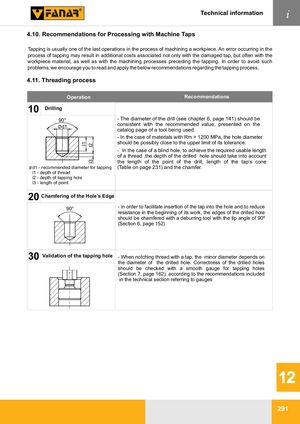Общий каталог FANAR 2021 - страница 294
Навигация

l1 l2l3 Technical information i 4.10. Recommendations for Processing with Machine Taps Tapping is usually one of the last operations in the process of machining a workpiece. An error occurring in the process of tapping may result in additional costs associated not only with the damaged tap, but often with the workpiece material, as well as with the machining processes preceding the tapping. In order to avoid such problems, we encourage you to read and apply the below recommendations regarding the tapping process. 4.11. Threading process Operation Recommendations 10 Drilling 90° - The diameter of the drill (see chapter 6, page 141) should be d1 consistent with the recommended value, presented on the catalog page of a tool being used. - In the case of materials with Rm > 1200 MPa, the hole diameter should be possibly close to the upper limit of its tolerance. - In the case of a blind hole, to achieve the required usable length of a thread ,the depth of the drilled hole should take into account the length of the point of the drill, length of the tap’s cone d1 - recommended diameter for tapping (Table on page 231) and the chamfer. l1 - depth of thread l2 - depth of tapping hole l3 - length of point 20 Chamfering of the Hole’s Edge 90° - In order to facilitate insertion of the tap into the hole and to reduce resistance in the beginning of its work, the edges of the drilled hole should be chamfered with a deburring tool with the tip angle of 90⁰ (Section 6, page 152) 30 Validation of the tapping hole - When notching thread with a tap, the minor diameter depends on the diameter of the drilled hole. Correctness of the drilled holes should be checked with a smooth gauge for tapping holes (Section 7, page 162), according to the recommendations included in the technical section referring to gauges 12 291
 Общий каталог FANAR 2018
Общий каталог FANAR 2018 Каталог FANAR цельные твердосплавные фрезы
Каталог FANAR цельные твердосплавные фрезы